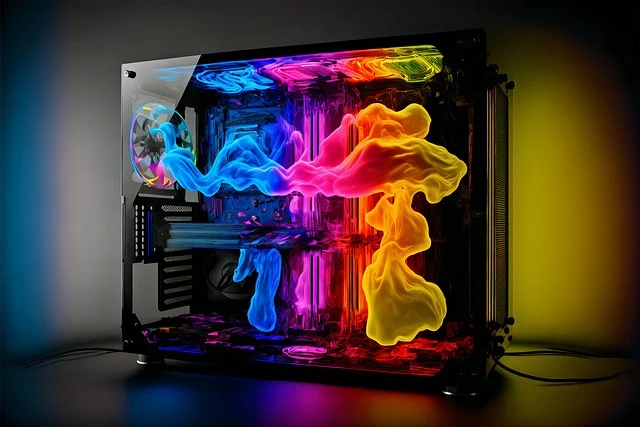
Gaming PCs are a powerful and versatile option for gamers seeking an enhanced and immersive experience. Unlike standard desktop computers, gaming PCs are designed with cutting-edge hardware and specialized features that cater to the high demands of modern video games. Whether you’re a casual gamer or a dedicated enthusiast, understanding the key components and considerations when building or purchasing a gaming PC is crucial. This article will dive deep into the essentials you need to know about gaming PCs, from the basic components to the more advanced configurations, along with tips for getting the best value for your investment.
1. Understanding the Core Components
At the heart of any gaming PC are several vital components that directly influence the gaming performance. Here’s a breakdown of the most important elements:
a. Central Processing Unit (CPU)
The CPU is the brain of your computer, handling general processing tasks and ensuring the smooth operation of games and applications. When choosing a CPU for gaming, you’ll want one that can keep up with the graphical demands of modern games. Popular options include Intel’s Core i5, i7, and i9 series, as well as AMD’s Ryzen 5, 7, and 9 processors.
In gaming PCs, a higher core count (like six or eight cores) can improve multitasking, but games typically rely more on single-core performance. Clock speed, measured in GHz, also plays a critical role—faster clock speeds mean quicker execution of tasks.
b. Graphics Processing Unit (GPU)
The GPU, or graphics card, is arguably the most crucial part of a gaming PC. It’s responsible for rendering the images, textures, and animations in a game, directly affecting frame rates and the overall visual quality. NVIDIA and AMD are the two major manufacturers of GPUs, with their GeForce and Radeon series, respectively, being the most popular among gamers.
When choosing a GPU, consider factors like the amount of VRAM (Video RAM) and the power of the card’s chipset. More powerful GPUs, such as NVIDIA’s RTX 3080 or AMD’s RX 6900 XT, allow for high-resolution gaming (1440p and 4K) and support features like real-time ray tracing, which enhances realism through more accurate lighting and reflections.
c. Random Access Memory (RAM)
RAM is the temporary storage that your system uses to manage active tasks. In gaming, sufficient RAM is essential for handling large game files, ensuring smooth gameplay, and preventing slowdowns. Most gaming PCs come with at least 16GB of RAM, which is considered the sweet spot for gaming in 2024. However, for users who want to future-proof their system or engage in heavy multitasking, 32GB may be a worthwhile investment.
d. Storage: SSD vs. HDD
Storage plays a significant role in gaming performance, particularly when it comes to load times and game installations. There are two primary types of storage: hard disk drives (HDD) and solid-state drives (SSD).
- HDDs are cheaper but slower. They are suitable for storing large files like videos or less frequently played games.
- SSDs are much faster and can drastically reduce load times in games. For gaming PCs, it’s recommended to use an SSD as your primary drive, especially for installing operating systems and your most-played games. NVMe SSDs are the fastest option available and offer incredible performance, though they are more expensive than traditional SATA SSDs.
e. Motherboard
The motherboard is the backbone of your gaming PC, connecting all components. When selecting a motherboard, compatibility with your CPU and GPU is paramount. Additionally, features like PCIe slots (for future GPU upgrades), USB ports, and integrated Wi-Fi can also influence your choice.
f. Power Supply Unit (PSU)
A good power supply is crucial for ensuring your system runs reliably. The PSU delivers electricity to all of your components, and it’s important to choose one with enough wattage to support your hardware, especially if you have a high-end GPU or plan to overclock your components. PSUs are rated by efficiency (Bronze, Silver, Gold, Platinum, Titanium), with Gold-rated PSUs offering a good balance between price and efficiency.
2. Pre-built vs. Custom-built Gaming PCs
When choosing a gaming PC, you can either opt for a pre-built system or build your own. Both options have their advantages and disadvantages.
a. Pre-built Gaming PCs
Pre-built gaming PCs are convenient, especially for those who may not have the time or expertise to assemble their own machine. Manufacturers like Alienware, ASUS, and HP offer gaming PCs that are ready to use out of the box. The main advantage here is convenience and ease of use—you don’t need to worry about compatibility issues or hardware assembly.
However, pre-built PCs tend to be more expensive than their custom-built counterparts. You’re paying a premium for the convenience of having everything set up for you, which can also mean you’re not getting the most value in terms of hardware. Additionally, pre-built systems may come with bloatware—unnecessary software that can slow down your machine.
b. Custom-built Gaming PCs
Building your own gaming PC is a popular choice among enthusiasts. This approach allows for full control over the choice of components, letting you tailor the system to your specific needs and budget. Additionally, building your own PC can be more cost-effective, as you can shop around for the best deals on individual components.
While building a PC can seem daunting, there are plenty of online guides and resources to help beginners through the process. Sites like PCPartPicker can help ensure compatibility between components, and the experience of building a PC can be rewarding for those who enjoy hands-on projects.
3. Cooling and Overclocking
a. Cooling Solutions
Effective cooling is essential for keeping your gaming PC running smoothly, especially if you’re pushing your hardware to its limits. There are two main types of cooling solutions:
- Air cooling: This involves heat sinks and fans to dissipate heat. It’s the more common and budget-friendly option, but it can be less effective in high-end gaming rigs.
- Liquid cooling: Liquid cooling systems offer superior cooling performance, particularly in high-performance builds. They are quieter and more efficient than air cooling systems, but they come at a higher cost and require more maintenance.
b. Overclocking
Overclocking is the process of pushing your CPU or GPU beyond its factory-set limits to achieve better performance. While it can offer noticeable improvements in frame rates and overall speed, overclocking can also increase the heat generated by your system, making adequate cooling all the more important. It also requires careful adjustments and testing to ensure system stability.
4. Peripherals and Accessories
A gaming PC is only as good as the peripherals and accessories that accompany it. For the best gaming experience, you’ll want to invest in high-quality peripherals, including:
- Monitors: High-refresh-rate monitors (120Hz or higher) provide a smoother gaming experience, especially in fast-paced games. Additionally, monitors with low response times and adaptive sync technology (G-Sync or FreeSync) can reduce screen tearing and stuttering.
- Keyboards and Mice: Mechanical keyboards are favored by gamers for their responsiveness and durability, while gaming mice often come with customizable buttons and adjustable DPI settings to enhance precision.
- Headsets: A good gaming headset with surround sound can elevate the gaming experience by immersing you in the game world and giving you a competitive edge in multiplayer games.
5. Future-Proofing and Upgradability
One of the benefits of a gaming PC is the ability to upgrade individual components over time. Unlike gaming consoles, which are limited by fixed hardware, a gaming PC can be continuously improved as new technology becomes available. When building or buying a gaming PC, consider future-proofing by choosing components that allow for easy upgrades.
For example, opting for a higher wattage PSU or a motherboard with multiple PCIe slots can save you from needing to replace these parts later. Additionally, prioritizing quality components for key areas like the CPU, GPU, and motherboard can ensure that your system remains competitive for years to come.



